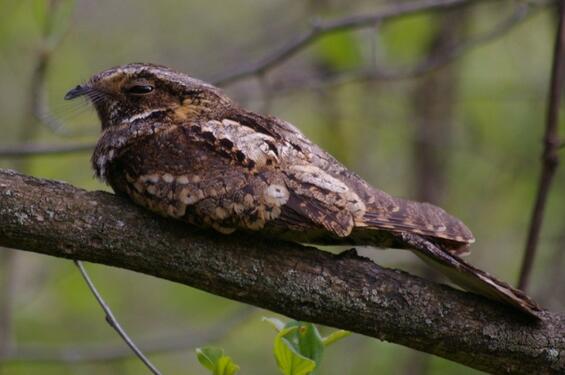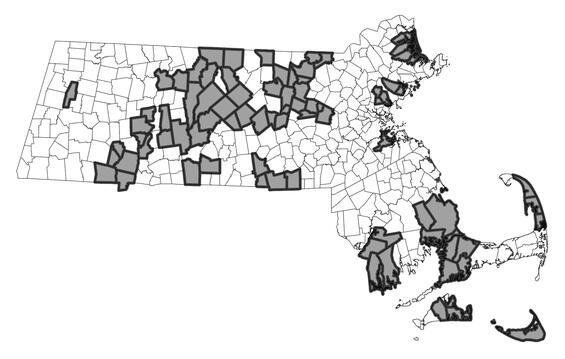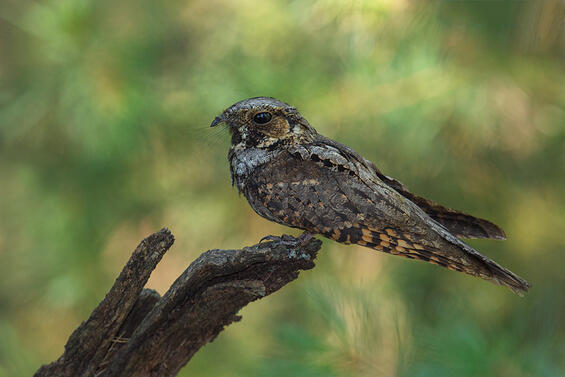- Scientific name: Antrostomus vociferus
- Species of Greatest Conservation Need (MA State Wildlife Action Plan)
- Special Concern (MA Endangered Species Act)
Description

Eastern whip-poor-will
Eastern whip-poor-wills are nocturnal birds of dry, open woodlands and clearings. They are seldom seen, though they are quick to announce their presence with their distinctive call on calm, moonlight nights from spring into mid-summer. The call is unmistakable: a rapidly whistled three-note phrase, “Whip-poor-will,” with an emphasis on the first and third notes. At close range, a brief introductory “cluck” can be heard in the call. Calling is most intense during crepuscular hours and during moonlit nights.
Whip-poor-wills measure 22-26 cm (8.7-10.2 inches) in length, and weigh between 43 and 64 g (1.5 and 2.3 ounces). Their body shape is distinct with a relatively small body always held horizontally when perched, and a large, flat head with large, dark eyes and a very small bill. The bill is bordered by long bristles for capturing food items in flight and opens to create a very large gape. The legs and feet are very small and seldom seen, always tucked against the body while perching or in flight. In flight, whip-poor-wills are slow and silent, appearing moth-like, often hovering and flying erratically in pursuit of flying insects.
The sexes are nearly identical in plumage: cryptically colored to match the streaked browns and grays of the forest floor. These color patterns blend perfectly into the sun-dappled oak leaf litter where they nest, or the thick branches that they perch on during the day. This camouflage is so effective that most birds are not detected until they are flushed by an approaching observer. In flight, a broad band of white on the outer tip of the tail can be seen on the male, and both sexes have a bright white patch on the throat, accented by a black border on the male and a buffy border on the female.
Life cycle and behavior
Whip-poor-wills have been recorded arriving in Massachusetts from their wintering grounds as early as mid-April, with pairs formed soon after and two eggs laid directly on the forest floor by mid-May. Whip-poor-will pairs are thought to be monogamous, at least through a single breeding season, and both members of the pair share the three weeks of incubation duties, followed by three weeks of brooding and feeding flightless chicks at the nest site. Chicks are able to feed themselves once they leave the nest, but parents have been observed feeding fledglings, and it is thought that family units associate with each other until their autumn migration, which in Massachusetts can be as late as the end of September. Very little is known about whip-poor-will migration, or about the whip-poor-will’s life history on their wintering grounds (along the Gulf of Mexico south to Central America).
The primary diet of whip-poor-wills is large moths and night-flying beetles. Whip-poor-wills hunt in the crepuscular hours and through the night when adequate moonlight allows, often perching on an exposed branch at a clearing’s edge and sallying forth in winged pursuit. Nest initiation typically occurs so that chicks hatch around a full moon, apparently to allow parents to maximize their hunting opportunities. Chicks are fed regurgitated insects. Their diagnostic “whip-poor-will” call is sung only by the male and issued both to attract a mate and to define their territory. Calling, like hunting, is usually most intense during the crepuscular hours, but will continue with intensity through the night when the moon’s disk is at least half illuminated.
Population status
Whip-poor-will was listed as special concern under the Massachusetts Endangered Species Act in 2011. Whip-poor-wills have historically bred across the entirety of Massachusetts, but beginning in the 1970s, they largely disappeared from the southern Connecticut River Valley, Bristol County, Berkshire County, and Plymouth County (with the exception of the greater Myles Standish barrens). They are also absent now from much of upper Cape Cod, with the exception of the Massachusetts Military Reservation–Frances Crane WMA complex, and from interior Essex County and most of Middlesex County.
Distribution and abundance
The whip-poor-will’s breeding range covers several distinct regions in North and Central America. Across this greater range, and separated by distinct morphological and behavioral differences, the whip-poor-will has been divided into two groups: the Eastern Group (vociferus group) and the Western Group (arizonae group). The Eastern Group, representing a single subspecies (A. v. vociferus), ranges from east-central Saskatchewan to southern Ontario and Quebec, central New Brunswick and central Nova Scotia, and from eastern Oklahoma to Georgia. Populations are discontinuous within the range of this Eastern Group. The Western Group’s breeding range is much more limited, extending from the southwestern United States discontinuously through the mountains of Mexico and into southern Guatemala and southwestern Honduras.
Currently there are only seven sites in Massachusetts that support 20 or more pairs of whip-poor-wills: the Greater Myles Standish Pine Barrens, the Montague Plains Pine Barrens, the Fort Devens/Bolton Flats WMA complex, the Massachusetts Military Reservation/Frances Crane WMA complex, Correllus State Forest and vicinity, the eastern half of Nantucket, and Muddy Brook WMA in Hardwick. There are only ten known sites that support 5-10 pairs, and of the remaining 100 or so known current sites in Massachusetts, the majority support just single pairs.

Distribution in Massachusetts. 1999-2024. Based on records in the Natural Heritage Database.
Habitat
Habitat needs for whip-poor-will are complex and our understanding of their specific requirements is still evolving. In general, whip-poor-wills seek dry, open woodlands with little understory adjacent to meadows and shrublands. The open woodlands are used for nesting and the adjacent meadows and shrublands are used for foraging.
Whip-poor-will distribution in Massachusetts appears to be closely correlated with fire-adapted landscapes such as pine barrens and oak glade communities. Until the 20th century, fire was a regular event in many areas of Massachusetts, either intentionally set by Native Americans and early farmers, or less commonly, wildfires from lightning strikes. Regular fire on a landscape typically results in the patchwork of open woodlands, sparse meadows, and shrublands needed by whip-poor-wills. Today, all of the remaining strongholds for whip-poor-will in Massachusetts occur in pine barrens that are actively managed with prescribed fire. Conversely, many historic records of whip-poor-will in Massachusetts occurred on landscapes that once supported fire-adapted natural communities and therefore likely saw regular fire. However, as fire has since been removed from these systems and the habitats have succeeded to denser, more generalized vegetation such as white pine stands, these landscapes have become unsuitable for breeding whip-poor-wills.
The primary habitats currently supporting whip-poor-wills in Massachusetts are:
- Barrens: fire-adapted habitats represented by open oak woodlands, warm-season grasses, scrub oak and pitch pine. Barrens currently support the vast majority of the state’s whip-poor-wills, and are represented by sites such as Myles Standish State Forest in Plymouth and Montague Plains Wildlife Management Area in Montague.
- Oak Glades: fire-adapted open woodlands that usually occur on ridges and dry slopes. Oak glades support small pockets of whip-poor-wills across the state and are represented by sites such as the Blue Hills Reservation in Canton, Mt. Tom in Holyoke, and the rocky balds of Cape Ann.
- Power Line Corridors: corridors through open forests sometimes support robust whip-poor-will populations, especially in dry situations where regular maintenance results in a vegetative structure resembling an often-burned landscape. The rocky, fire-prone corridors through Salem and Peabody are a good example.
- Abandoned Gravel Operations: gravel extraction takes place in areas of glacial outwash, the foundation of most Barrens Communities. The act of exposing the base substrate and then letting it regenerate on its own often leads to the establishment of quality barrens-type habitat capable of supporting whip-poor-wills.
- Logging Operations: depending on landscape context, logging can create the diverse, semi-open landscape that is sought by whip-poor-wills.
Healthy habitats are vital for supporting native wildlife and plants. Explore habitats and learn about conservation and restoration in Massachusetts.

Eastern whip-poor-will
Threats
There has been a dramatic retraction in distribution and abundance of whip-poor-wills across the state beginning in the 1960s. A combination of factors has likely contributed to this decrease, primary among them habitat loss both from development and from habitat succession. Population loss from development is clearly illustrated in the greater Boston and greater Springfield areas, where whip-poor-wills were described as common into the early 20th century but are now absent. More recent retractions correlate with development trends over the past several decades. Many areas that have lost whip-poor-wills since the 1970s are also areas of the state that have experienced the greatest conversion of forest to development during that time. Plymouth and Bristol Counties, Lower Cape Cod, and the Upton-Grafton areas have experienced some of the greatest development pressure in recent decades while also experiencing the greatest retractions in whip-poor-will presence.
Population retractions in areas not lost to development often appear to be the result of habitat succession. While many of these areas are still in a natural state, a closer look shows that often these sites are declining pine barrens or upland oak forest with evidence of historical fire. Fire suppression, first widely incorporated in Massachusetts in the 1930s, has caused a shift in these fire-adapted communities toward the more generalist species structure that we see today. This succession away from fire-adapted natural communities likely plays the largest role in current population declines.
Declines in large moths, predation by domestic and feral cats, and road mortality are other factors that have been suggested as contributing to declining whip-poor-will populations in the Northeast, but the relative importance of each of these is largely unknown. The importance of predation by native predators as a factor limiting reproductive success and adult survival is also poorly understood. Likewise, the extent to which limiting factors during non-breeding periods (migration and winter) affect whip-poor-wills that breed in Massachusetts is unknown.
Predation by domestic cats has been identified as the largest source of mortality for wild birds in the United States with the number of estimated mortalities exceeding 2 billion annually. Cats are especially a threat to those species that nest on or near the ground.
An additional threat to the species is collisions with buildings and other structures, as approximately 1 billion birds in the United States are estimated to die annually from building collisions. A high percentage of these collisions occur during the migratory periods when birds fly long distances between their wintering and breeding grounds. Light pollution exacerbates this threat for nocturnal migrants as it can disrupt their navigational capabilities and lure them into urban areas, increasing the risk of collisions or exhaustion from circling lit structures or areas.
Conservation
It is unlikely that whip-poor-will will be able to reclaim its former distribution across Massachusetts because many former haunts have been rendered uninhabitable due to permanent habitat loss and/or degradation. Instead, conservation should focus on protecting, restoring and managing existing whip-poor-will habitat across the state. Coordinating with land managers, landowners and foresters to ensure that existing whip-poor-will habitat remains viable is key in stabilizing the state’s population.
Management
Active restoration and management of whip-poor-will habitat depends upon reintroducing a disturbance regime to the landscape. The exact prescription for management will be unique for each site, but examples of general actions include:
- Introducing prescribed fire to the landscape where appropriate.
- Conducting logging that results in woodland structure and oak-dominated composition.
- Allowing spent gravel mines to succeed naturally, rather than requiring closure plans that call for loam and seeding to turf grasses.
- Siting development as far from whip-poor-will habitat as possible to conserve habitat and lessen the effects of pets, light/noise pollution, insecticides, roads, etc.
All work, including habitat management, proposed in known whip-poor-will habitat is subject to review under the Massachusetts Endangered Species Act, and should be planned in close consultation with the Massachusetts Natural Heritage and Endangered Species Program.
Annual, standardized surveys of calling adults during the breeding season at known sites should be used to track population trends, assess the effectiveness of management, and guide future actions.
Research is sorely needed to characterize and understand basic aspects of whip-poor-will ecology and demographics, including reproductive success, age-specific survival rates, factors limiting reproductive success and survival, details of nesting and foraging habitat preferences, and responses of habitats and breeding populations to management.
Promote responsible pet ownership that supports wildlife and pet health by keeping cats indoors and encouraging others to follow guidelines found at fishwildlife.org.
Bird collision mortalities can be minimized by making glass more visible to birds. This includes using bird-safe glass in new construction and retrofitting existing glass (e.g., screens, window decals) to make it bird-friendly and reducing artificial lighting around buildings (e.g., Lights Out Programs, utilizing down shielding lights) that attract birds during their nocturnal migration.
References
Cink, C.L. 2002. Whip-poor-will (Caprimulgus vociferus). In The Birds of North America, No. 620 (A. Poole and F. Gill, eds.). The Birds of North America, Inc., Philadelphia, PA.
Chesser, R. T., et al. 2010. Fifty-first supplement to the American Ornithologists’ Union Check-list of North American Birds. Auk 127(3): 726-744.
Forbush, E. 1927. Birds of Massachusetts and Other New England States. Massachusetts Department of Agriculture. Norwood Press, Norwood, MA.
Hill, N. 1965. The Birds of Cape Cod, Massachusetts. William Morrow and Co., New York, NY.
Massachusetts Audubon Society. 2009. Losing Ground IV: Patterns of Development and Their Impacts on the Nature of Massachusetts. Massachusetts Audubon Society, Lincoln.
Motzkin, G., Patterson, W. A., Foster, D. R. 1999. A historical perspective on pitch pine-scrub oak communities in the Connecticut Valley of Massachusetts. Ecosystems 2: 255-273.
Petersen, W. R. and W. R. Meservey. 2003. Massachusetts Breeding Bird Atlas. Massachusetts Audubon Society, Lincoln, MA.
Sauer, J.R., J.E. Hines, and J. Fallon. 2008. The North American Breeding Bird Survey, Results and Analysis 1966-2007. Version 5.15.2008. USGS Patuxent Wildlife Research Center, Laurel, MD. http://www.mbr-pwrc.usgs.gov/bbs/bbs.html
USGS North American BBA Explorer. Massachusetts Breeding Bird Atlas 1974-1979. Massachusetts Audubon Society, Lincoln. http://www.pwrc.usgs.gov/bba/index.cfm?fa=explore.ProjectHome&BBA_ID=MA1974
USGS North American BBA Explorer. Massachusetts Breeding Bird Atlas 2007-2011. Massachusetts Audubon Society, Lincoln. http://www.pwrc.usgs.gov/bba/index.cfm?fa=explore.ProjectHome&BBA_ID=MA2007
Veit, R.R., and W.R. Petersen. 1993. Birds of Massachusetts. Massachusetts Audubon Society, Lincoln. MA.
Contact
| Date published: | April 2, 2025 |
|---|